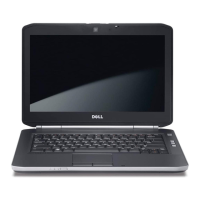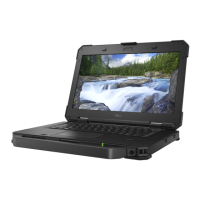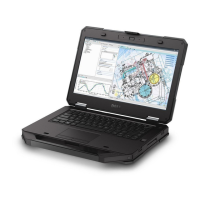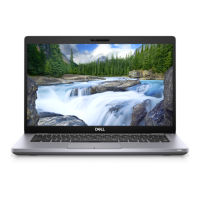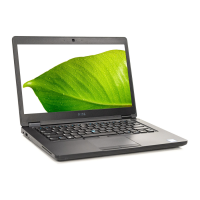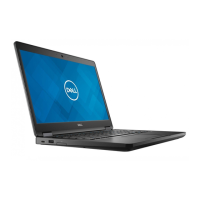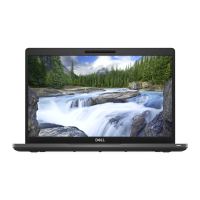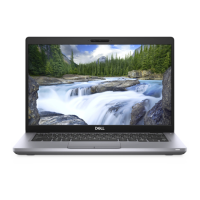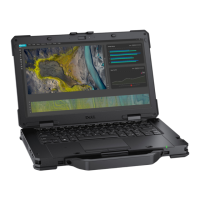What to do if my Dell Latitude 5421 has an unrecoverable SPI flash failure?
- SSamantha DelgadoSep 9, 2025
If your Dell Laptop experiences an unrecoverable SPI flash failure, replace the system board.
What to do if my Dell Latitude 5421 has an unrecoverable SPI flash failure?
If your Dell Laptop experiences an unrecoverable SPI flash failure, replace the system board.
What to do if my Dell Laptop's EC is unable to program i-Fuse?
If the EC on your Dell Laptop is unable to program i-Fuse, replace the system board.
What to do if my Dell Laptop has a power rail failure?
If your Dell Laptop experiences a power rail failure, replace the system board.
What to do if my Dell Latitude 5421 has a timeout waiting on ME to reply to HECI message?
If your Dell Laptop shows a timeout while waiting for ME to reply to a HECI message, replace the system board.
General safety guidelines for protecting the computer and personal safety.
Procedures and precautions before and after working inside the computer.
How to enter service mode to safely perform repairs without disconnecting the battery.
Steps to exit service mode and return the computer to normal operation.
Steps to follow after completing internal computer maintenance.
List of essential tools required for component removal and installation procedures.
Detailed table of screws used for different components, including type and quantity.
Visual identification and labeling of key internal components within the laptop.
Procedure for removing and installing the SIM card tray for WWAN-equipped systems.
Instructions for removing and installing the microSD card from its slot.
Steps for removing and installing the bottom panel of the computer.
Procedures for removing and installing the wireless (WLAN) card.
Steps for removing and installing the WWAN card for cellular connectivity.
Detailed instructions for removing and installing M.2 2230 and 2280 solid-state drives.
Procedures for removing and installing memory modules (RAM).
Safety precautions and steps for removing and installing the lithium-ion battery.
Instructions for disconnecting and reconnecting the battery cable.
Steps for removing and installing the internal frame structure of the laptop.
Procedures for removing and installing the LED indicator board.
Instructions for removing and installing the heat sink and fan for UMA and Discrete configurations.
Steps for removing and installing the internal speaker modules.
Procedures for removing and installing the USB Type-C port bracket.
Detailed steps for removing and installing the main system board.
Instructions for removing and installing the power button and its associated board.
Procedures for removing and installing the smart card reader component.
Steps for removing and installing the coin-cell battery, noting BIOS reset.
Instructions for removing and installing the entire keyboard assembly.
Procedures for removing and installing the keyboard support bracket.
Comprehensive steps for removing and installing the entire display unit.
Instructions for removing and installing the display screen bezel.
Detailed steps for removing and installing the actual LCD display panel.
Procedures for removing and installing the camera and microphone components.
Instructions for removing and installing the eDP/display cable.
Procedures for removing and installing the sensor board.
Steps for removing and installing the display hinges.
Instructions for removing and installing the rear cover of the display assembly.
Procedure for removing and installing the dummy SIM card slot filler.
Steps for removing and installing the palm-rest assembly, including touchpad and keyboard.
Guide on how to download and install necessary drivers for the computer.
Explanation of the BIOS and its role in system management.
Instructions on how to access the BIOS setup utility.
Description of keys used for navigating within the BIOS setup menus.
How to access and use the one-time boot menu to select boot devices.
Overview of various configurable options within the BIOS setup menus.
Detailed steps for updating the BIOS via Windows, USB, or F12 menu.
Information on setting, changing, and clearing system and BIOS passwords.
Procedure for creating new system and setup passwords for security.
Steps to modify or remove existing system and setup passwords.
Instructions for clearing CMOS settings, which resets BIOS to defaults.
Guidance on how to clear system and BIOS passwords by contacting support.
Safety guidelines and procedures for handling swollen lithium-ion batteries.
How to run pre-boot diagnostics to check hardware performance.
Information on system board self-tests like M-BIST and LCD BIST.
Specifics on initiating and understanding the M-BIST diagnostics for system board issues.
How to invoke the L-BIST test to diagnose LCD power issues.
Procedure for running the LCD built-in self-test to isolate screen problems.
Interpretation of system diagnostic lights (power/battery status) for error codes.
Steps for using Dell SupportAssist OS Recovery to fix OS issues.
Procedure for performing an RTC reset to resolve No POST/No Power/No Boot issues.
Recommendations for creating backup media for Windows recovery.
Instructions for troubleshooting WiFi connectivity issues by power cycling devices.
Procedure for draining residual power to resolve boot or power-on issues.
Guide on how to contact Dell support for sales, technical, or customer service.
| Storage | Up to 2TB PCIe NVMe SSD |
|---|---|
| Processor | Up to 11th Generation Intel Core i7 |
| Display | 14-inch, FHD (1920 x 1080), Anti-Glare, Non-Touch |
| Memory | Up to 64GB DDR4 |
| Graphics | Intel UHD Graphics |
| Operating System | Windows 10 Pro |
| Battery | 4 Cell |
| Ports | 2x USB 3.2, HDMI 2.0, RJ-45, microSD card reader, headphone/microphone combo jack |
| Weight | 1.59 kg |
| Wireless | Intel Wi-Fi 6 AX201, Bluetooth |
